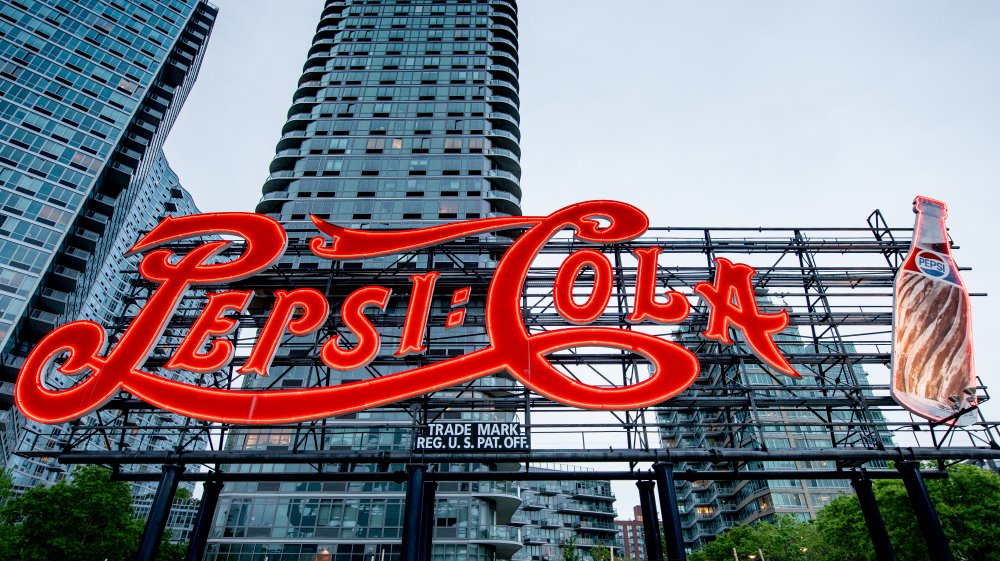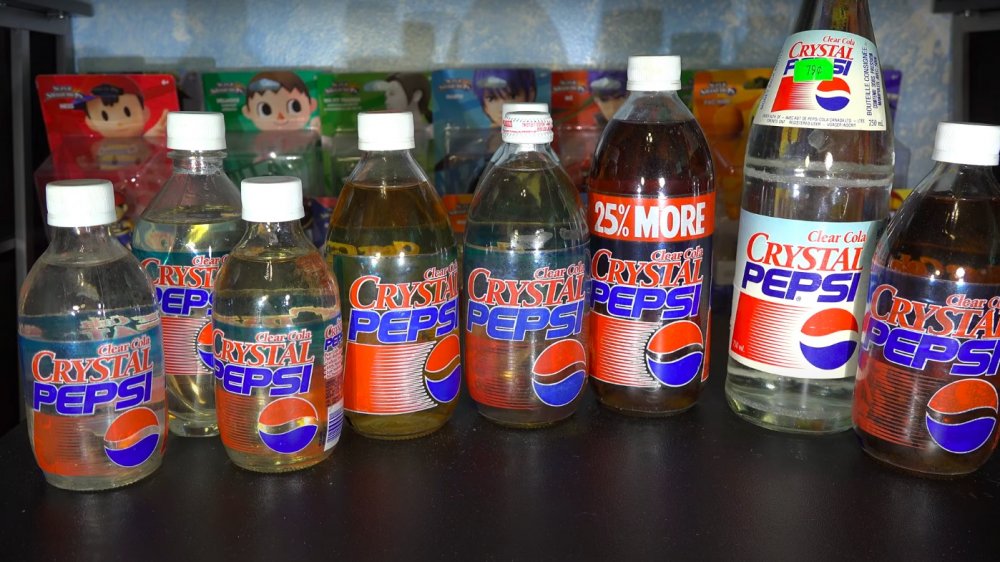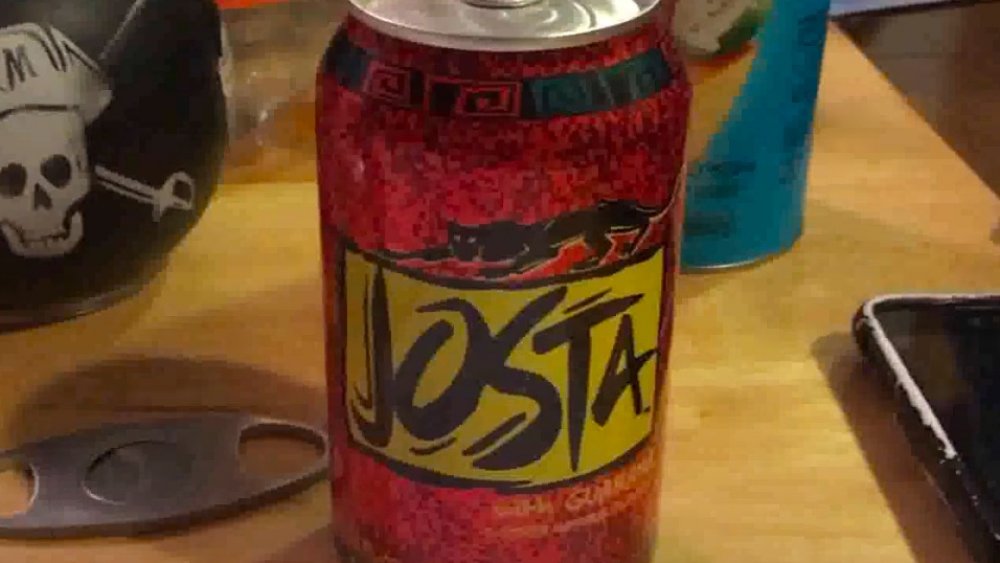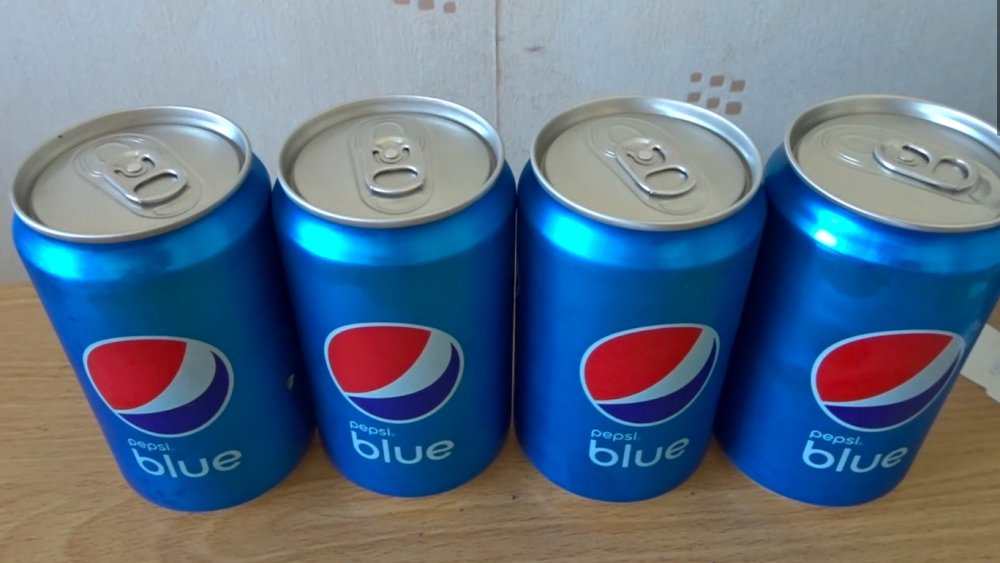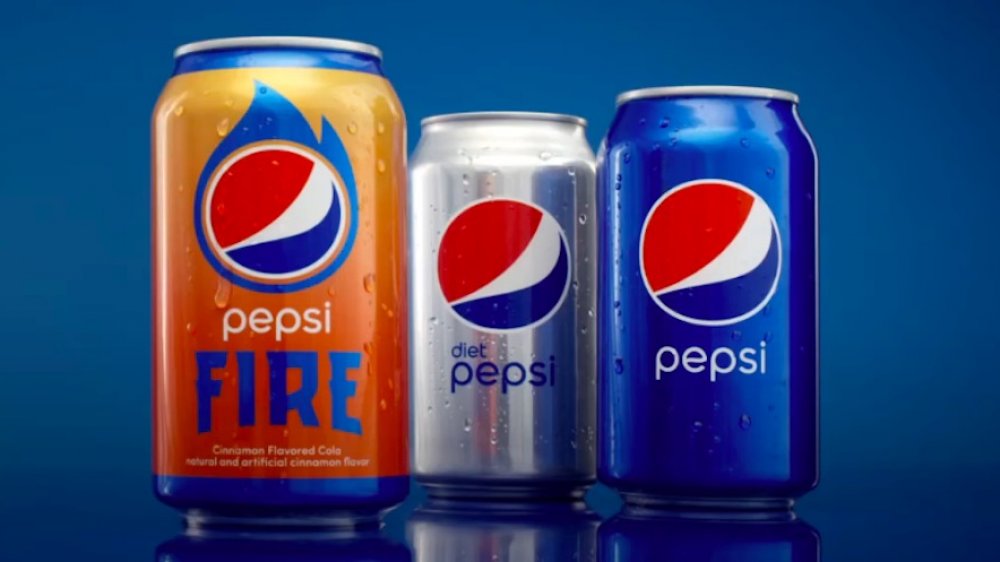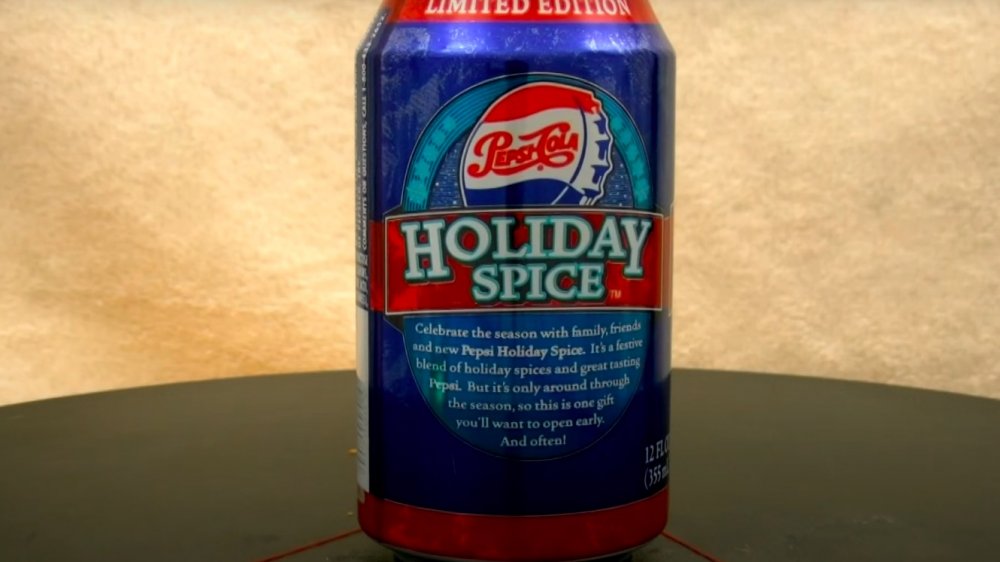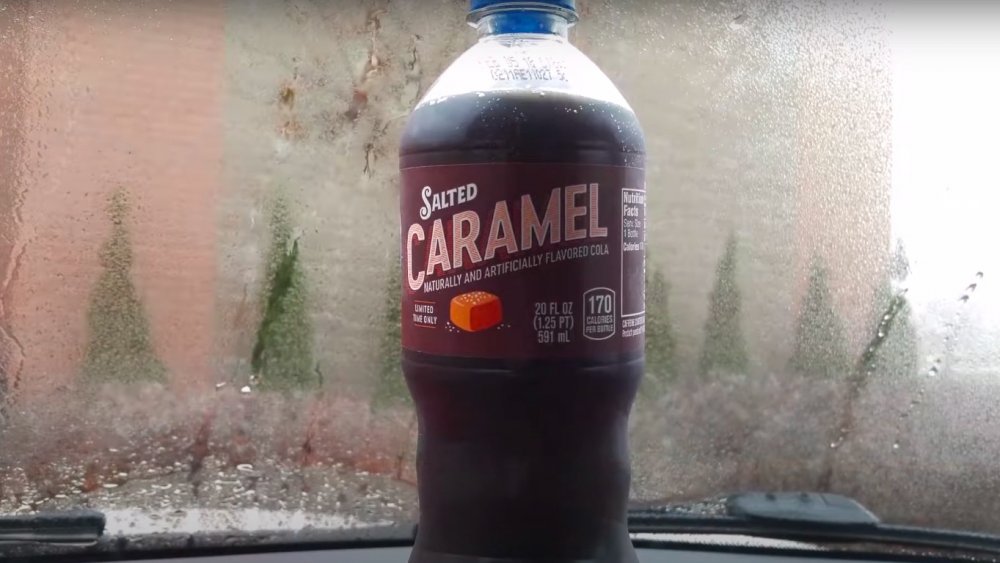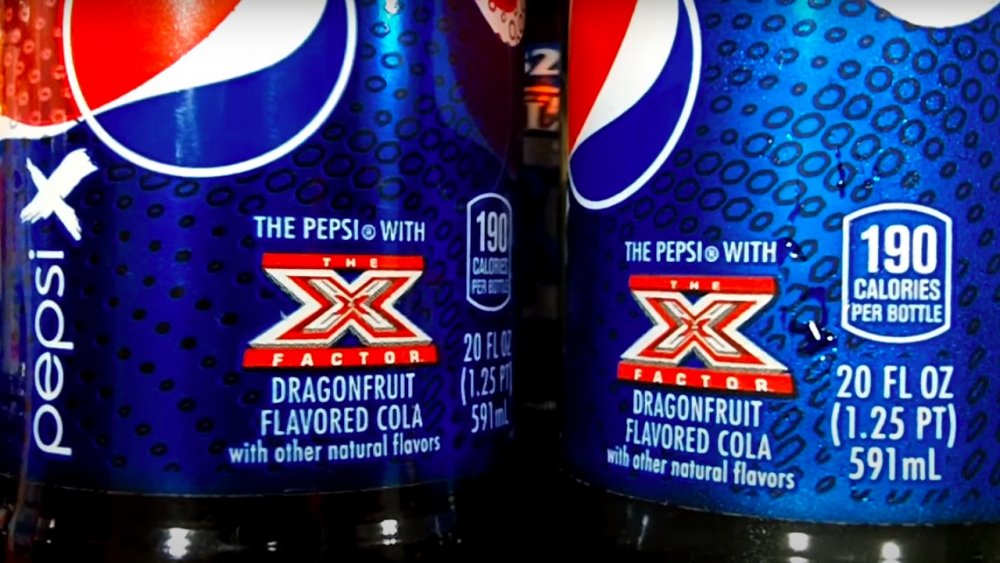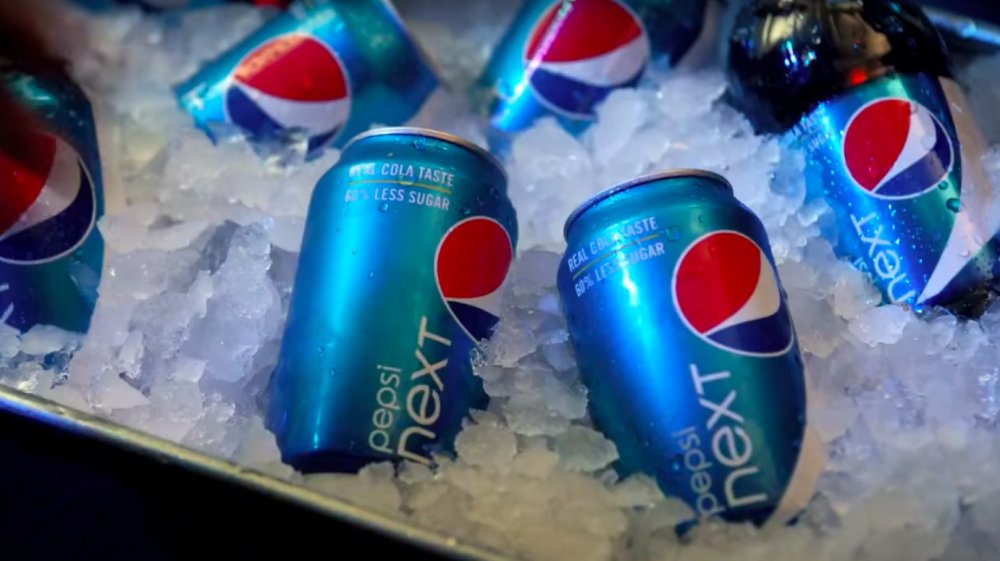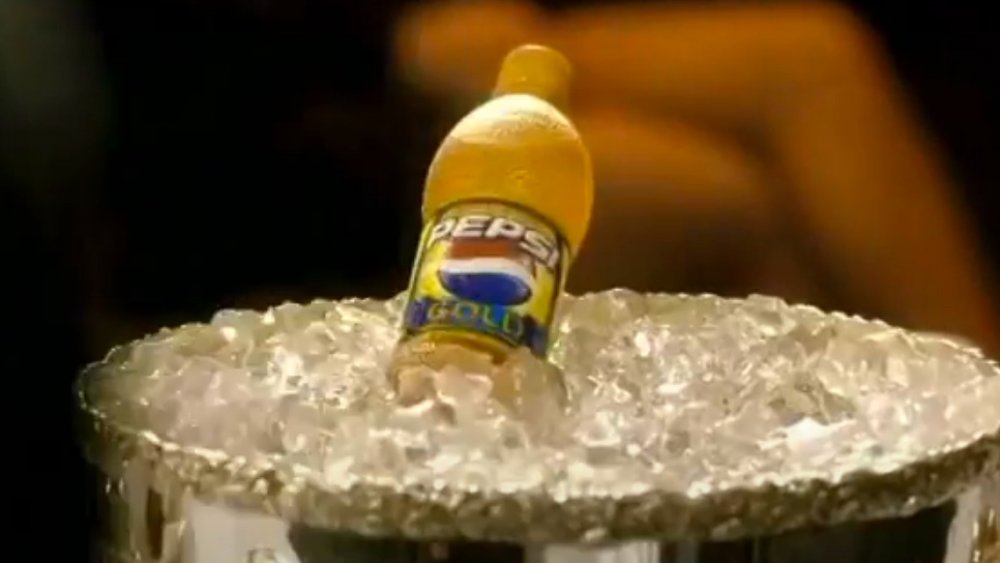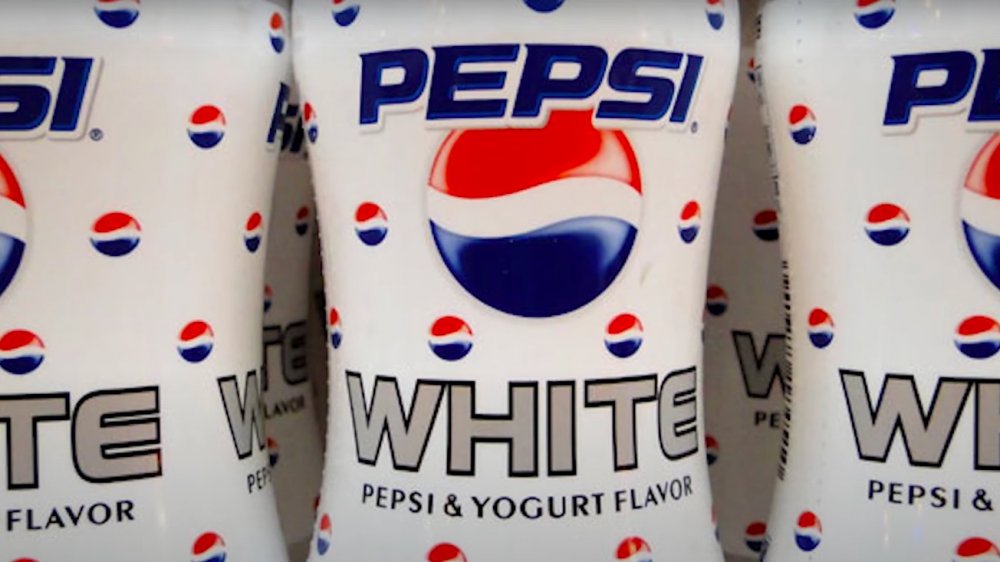Pepsi Products That Were Massive Fails
Back in 1893, North Carolina pharmacist Caleb D. Bradham created his own version of the wildly popular new beverage called Coca-Cola, giving his knock-off the not-particularly-catchy monicker "Brad's Drink." A name change in 1898 resulted in the birth of Pepsi-Cola, that new name derived from "dyspepsia" due to Bradham's belief that his concoction would prove beneficial for indigestion.
As the popularity of both sodas increased over the decades that followed, Pepsi and Coke both grew to become massive multinational corporations — and, along the way, cutthroat rivals. As History recalled, the competition between the two companies hit its zenith in the 1980s, with each company pulling out all the stops to create innovative new products that would hopefully steal market share from the other.
Yet not all of the products that the companies unleashed upon unsuspecting consumers turned out to be winners. The ill-fated launch of New Coke, for example, would go down as one of the biggest marketing blunders in history, yet Pepsi can lay claim to some massive mistakes of its own. To discover embarrassing examples of soda marketing gone awry, read on for a look at some Pepsi products that were massive fails.
Crystal Pepsi's high-profile launch was an expensive disaster
A weird trend emerged in the early 1990s: clear, colorless sodas. At the forefront was Crystal Pepsi, unveiled in a Super Bowl commercial featuring a Van Halen hit and the tagline, "You've never seen a taste like this." As Crystal Pepsi's inventor, David Novak, told Business Insider, the intent was to capitalize on consumers' new desire for products that were pure and natural. By ditching the caffeine and the cola's distinctive brown color, Novak was certain those health-conscious customers would gravitate to Crystal Pepsi.
Initial test-tasting was encouraging, and Novak felt he had a hit on his hands. The people at the plant that bottled the stuff, however, weren't so sure; they thought the clear soda should "taste more like Pepsi." Novak, however, admitted that he "didn't want to hear it. I was rolling the thing out nationally and I didn't listen to them."
He really should have. While sales were solid at first, once consumers satisfied their curiosity they didn't come back for more. After spending $40 million on marketing, Crystal Pepsi was yanked. Years later, Time ranked the soda among its "10 worst product fails of all time."
Pepsi's heavily caffeinated Josta never caught on
Back in 1995, PepsiCo was experimenting with a new soda that featured the guarana berry, described in an Associated Press report as "a mystical Amazon jungle berry that's widely considered among Brazilians to be a sexual stimulant." The company's new guarana-infused cola, dubbed Josta, didn't expand on those claims, but did promote guarana's high caffeine content, about three times that of coffee beans.
By early 1999, it was clear that Josta was a flop when the Los Angeles Times reported that a Pepsi spokesperson confirmed it was being discontinued.
Years after the soda's failure, some hardcore Josta fans have engaged in quixotic efforts urging Pepsi to revive the brand. As Daily Dot noted, one Josta enthusiast organized a National Josta Day in 2007, while another missed it so much he experimented with various flavor combinations until perfecting a homemade substitute dubbed Josta Reborn, declaring it had "nearly the same red tint, same nasal-clearing aroma" as the original. Despite efforts such as these, a Josta comeback seems unlikely. A petition urging Pepsi to bring back the beverage was shut down after garnering a measly 223 signatures.
Pepsi Blue was an idea whose time had not come
Pepsi Blue was first announced in 2002, described by CNN as a "blue-hued berry-flavored cola" that was aimed squarely at teenagers. "Pepsi Blue has the potential to reinvigorate the cola category," said PepsiCo North America CEO Gary Rodkin of the new offering, one of "more than a 100 concepts" the company had been testing. The company's senior vp of marketing assured CNN that most of the teenagers surveyed loved the idea of a blue cola.
Convenience Store News cited a report from Beverage Digest indicating 17 million cases of Pepsi Blue were sold during its first year on the market. Yet sales dropped precipitously the following year, with the Atlanta Journal-Constitution (via BevNews.com) reporting less than 5 million cases were sold in 2003, a rather measly number in the soft drink world, and in 2004, Pepsi Blue was discontinued.
As Katie Lacey, Pepsi-Cola North America's vp of marketing, told The Journal-News (via Convenience Store News) the failure of Pepsi Blue was instructive. "I think one of the things we learned is that colas probably need to stay brown," she admitted. "It is one of the uniquely distinct characteristics of colas."
Cinnamon-flavored Pepsi Fire was a soda that nobody needed
In the summer of 2017, Pepsi came up with the marketing tagline "Get It While It's Hot" to accompany the launch of Pepsi Fire, a new cola that boasted a spicy "cinnamon-flavored twist." In a press release heralding its arrival, Pepsi marketing director Lauren Cohen promised that "Pepsi Fire is going to ignite this season with an unexpected and spicy twist to our classic cola taste," sweetening the pot by offering a sweepstakes contest in which consumers could win "big-ticket prizes."
Oddly enough, Pepsi Fire was earlier introduced to Asian markets in 2004 alongside another new offering, spearmint-flavored Pepsi Ice, with both eventually discontinued despite a hefty marketing campaign that included an extravagant Lord of the Rings-inspired commercial. Unfortunately, consumer opinions about cinnamon-flavored cola hadn't evolved during that time, and the second coming of Pepsi Fire was not welcomed.
A review from the Taste of Home website indicated that one big reason may have been that the cinnamon flavoring was too subtle, and only came through in the aftertaste. The review compared the cola's overall taste to chewing Big Red cinnamon gum and then swigging a Pepsi.
Pepsi's Holiday Spice didn't succeed, but fans still want it back
In the lead-up to Christmas 2004, Pepsi rolled out a new cola with a distinctive holiday theme. Pepsi Holiday Spice, declared the packaging, offered "a festive blend of holiday spices and great-tasting Pepsi" (those spices, noted a CNN report, were predominantly cinnamon and ginger). The limited-time offering of Holiday Spice was only available during November and December.
Sales were apparently not deserving of a return, and the following November those who'd become fans of Pepsi Holiday Spice were disappointed when it didn't reappear on store shelves.
Pepsi Holiday Spice, however, seems to be an example of that old axiom about how absence makes the heart grow fonder; even though it hasn't been around since 2004, there are those who still call for its return. In fact, two separate petitions — one launched in 2006, the other in 2014 — urge PepsiCo to bring it back. That 2014 petition, in fact, declared that "this drink brought happiness and was liked by many until it was gone. Now, the consumers want more."
Salted Caramel Pepsi was greeted with social media mockery
Salted caramel was first popularized by chef Pierre Hermé in the 1990s, eventually breaking through into the U.S. market. Witnessing the salty confection's growing popularity, Pepsi execs saw an opportunity to create a new salted-caramel flavor of the iconic cola. Introduced during the 2017 holiday season, a press release described Salted Caramel Pepsi as adding a "delicious caramel finish" to "the refreshing taste of cola."
NBC's Today did a taste test, concluding it was "surprisingly drinkable but it didn't knock our socks off." Noting there was "nothing wildly unusual or inoffensive about" the soda, the review noted "a sweet aftertaste that's slightly reminiscent of Werther's candy."
Meanwhile, the reaction on social media was all over the map. While some claimed to be "digging" the new flavor, there were plenty who were not so enthralled. "This tastes like watery Pepsi that someone threw a single dirty caramel into," tweeted one critic, while another described the taste as "like someone put a pancake covered in syrup in a Pepsi bottle." Another Twitter user, who professed to enjoy both salted caramel and Pepsi, admitted "this combo just made me retch a bit."
The X Factor-themed Pepsi X wasn't a crowd-pleaser
Pepsi had some new flavors to try out and Simon Cowell had a new TV show to shill. This led to some network-soda synergy in 2011, when the brand became the sponsor of the American Idol judge's new Fox talent show, The X Factor. With hopes high that The X Factor would become an Idol-sized success, Pepsi was eager to participate, given that Coke had sponsored Idol.
"It's been the most collaborative relationship I've ever had with a sponsor," Cowell told The New York Times, noting that he and the show's other producers "consulted with them in all the decisions, and they came and presented to us their own marketing ideas." One of those ideas was Pepsi X, a new soda flavor that would be chosen by the show's viewers.
BevNet reported that to coincide with the debut of The X Factor's second season in 2012, the brand launched the "Pepsi Flavor Audition Tour," giving fans the opportunity to sample four different flavors and vote for their favorite. The winning flavor of the limited-edition cola, noted TrendMonitor was dragonfruit. Ultimately, both the soda and the show proved to be flops.
Pepsi Next offered less sugar, but consumers didn't care
In 2012, the soda giant launched Pepsi Next, a "mid-calorie" soda that offered about half the calories of regular Pepsi. Devised as a hybrid of regular and diet soda, Pepsi Next cut back on high-fructose corn syrup while adding artificial sweeteners to make up the difference. According to Consumer Reports, testers who sampled the beverage felt the taste was similar to that of a regular soda.
As Beverage Daily reported, PepsiCo CEO Indira Nooyi said Pepsi Next was "created for consumers who seek the rich taste of full-calorie cola" but had yet to adapt their tastebuds to "the flavor profile of a zero-calorie cola." The overall goal, she explained, was to lure "lapsed cola users" back to the fold.
Despite a massive advertising campaign featuring actress Paula Patton and rapper Nicki Minaj as "spokesperson," Pepsi Next fizzled, and was eventually discontinued. As Dr. Yoni Freedhoff, author of The Diet Fix, told CBC News, from a health perspective the product appealed to neither diet soda aficionados nor fans of regular sugary sodas. Pepsi Next, he explained, "is a slightly less bad version of a terrifically bad product."
Ginger-flavored Pepsi Gold targeted sports fans
Pepsi had its eye on making a few bucks from the 2006 FIFA World Cup, and came up with Pepsi Gold, aimed at soccer fans in Europe and Asia.
According to a press release shared by Thai broadcaster RYT9, the gold-colored cola capitalized on the "golden year of football." Pepsi-Cola marketing director Charlie Jitcharoongphorn explained how the new honey-hued Pepsi — packaged in a golden "grip bottle" — was meant to encourage fans to cheer on their favorite teams while chugging it down. Citing statistics that 71 percent of those who had tried Pepsi Gold would "definitely buy it again," he shared his belief that "Pepsi Gold will add more spirit and excitement to all football fans and the entire cola market."
The fact that most people have never heard of Pepsi Gold is an indicator of its success, but it certainly wasn't for lack of trying. The product's marketing campaign revolved around a TV commercial featuring French soccer great Theirry Henry and supermodel Claudia Schiffer. Meanwhile, Pepsi Gold has subsequently launched once again, this time boasting a new lemon-tinged flavor and targeting fans of cricket — the sport, not the insect.
Consumers wisely steered clear of yogurt-flavored Pepsi White
Show of hands for anyone who's ever taken a refreshing swig of Pepsi and thought, "Gee, that tastes great, but what it really needs is some yogurt." As bizarre as that may seem, it was apparently the thinking behind Pepsi White, a Japan-only offering that first hit shelves in 2008. In 2012, ABC News reported that Suntory — which distributes Pepsi in Japan — was launching a revamped Pepsi White, a Christmas-themed, white-colored Pepsi variant with a citrus flavor. That article also referenced the original 2008 version, described as "a yogurt-flavored" Pepsi.
That yogurt-enhanced 2008 product apparently didn't last long; while it was available, however, the Japanese Snack Reviews blog offered an assessment of the bonkers beverage, pointing out that those who sampled it and blogged about the experience "wondered why it exists at all." The consensus, the blogger theorized, was that Suntory was "trying to be too wacky" with weird "short-lived varieties" to capitalize on the curiosity factor before the limited-distribution period winds down.
Ultimately, the blogger described Pepsi White as a "peculiar drink" that, to its credit, is exactly what it was billed as, offering the "taste of Pepsi with a rather "odd" yogurt aftertaste.
